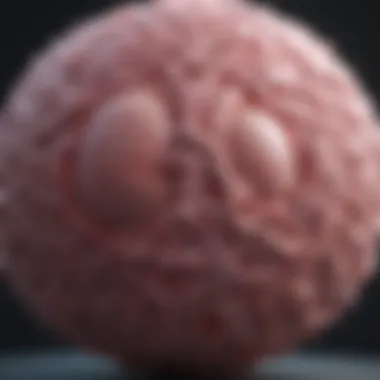Advancements in Breast Cancer PDX Models


Intro
Understanding breast cancer research has become a pivotal aspect of improving therapeutic strategies and clinical outcomes. One of the most promising areas of study involves patient-derived xenograft (PDX) models. These models provide a unique window into the complexities of tumor behavior and response to treatment. By using human tumor tissue implanted in immunocompromised mice, researchers can closely observe how individual tumors react to various therapies, which paves the way for more personalized medicine.
In this discourse, we will explore the significance of PDX models in breast cancer research, examining both their potential and limitations in the quest for effective treatments. This journey includes delving into specific methodologies, challenges faced in the development of these models, and notable case studies that illustrate their practical applications. As we unfold this subject, we aim to provide a comprehensive understanding of how PDX models are reshaping the landscape of breast cancer research.
Overview of Research Topic
Brief Background and Context
Breast cancer remains one of the leading causes of cancer-related mortality among women. Traditional research methods often fall short, as they may not accurately represent the heterogeneity seen in human tumors. The emergence of PDX models has revolutionized this area by allowing for greater insights into individual tumor characteristics and behaviors. These models utilize fresh tumor isolates from patients, maintaining the genetic and phenotypic traits of the original tumors, which enables more relevant preclinical testing.
Importance in Current Scientific Landscape
In the current scientific arena, PDX models hold significant promise. They allow scientists to evaluate drug responses and resistance mechanisms more effectively than ever before. As personalized medicine gains traction, the ability to tailor treatment plans based on specific tumor characteristics has never been more crucial.
"Patient-derived xenograft models offer a relevant platform to study the biological complexity of human tumors, ultimately guiding more tailored therapeutic approaches."
The focus on personalized medicine aligns with the urgent need to address breast cancer in a meaningful way, as one-size-fits-all approaches are increasingly viewed as inadequate. PDX models also play a vital role in identifying new therapeutic targets and testing innovative drug combinations before they reach clinical trials, ultimately enhancing the likelihood of successful treatment outcomes.
Methodology
Research Design and Approach
The construction of PDX models involves a meticulous method that combines surgical techniques with sophisticated biological knowledge. Initially, tumor samples are carefully excised from patients undergoing surgical intervention. These samples are then grafted into the flanks of immunodeficient mice, where they can grow and develop in a controlled environment. The models are monitored for tumor growth, histopathological analysis, and genetic profiling, providing rich data that reflect the original tumor characteristics.
Data Collection Techniques
Once established, various data collection methods come into play. Researchers often employ imaging techniques, such as MRI and PET scans, to monitor tumor progression. Additionally, tissue samples can be harvested at different stages to analyze molecular changes during treatment. This data is invaluable, as it sheds light on drug efficacy and resistance mechanisms at multiple levels.
In summary, as we navigate through the nuances of breast cancer PDX models, we will reveal how these sophisticated methods contribute to understanding tumor behavior and improving therapeutic approaches. The coming sections will delve deeper into case studies and challenges to provide a holistic view of this intriguing field.
Preamble to Breast Cancer and PDX Models
Breast cancer remains a significant public health challenge worldwide, affecting millions of women and their families. As research continues to evolve, understanding the nuances of tumor behavior is more critical than ever. This is where Patient-Derived Xenograft (PDX) models come into play. They offer a window into the complex environment of human tumors, providing researchers with invaluable insights into breast cancer's biology and potential treatment responses.
Understanding Breast Cancer
Breast cancer is not a single entity but a collection of diseases with distinct biological characteristics. It can manifest in various forms such as ductal carcinoma in situ, invasive ductal carcinoma, and triple-negative breast cancer, to name a few. Each subtype responds differently to treatment, leading to a landscape where individualized therapy is paramount. Early detection through screening offers some hope, but once diagnosed, the journey can be fraught with challenges.
Factors influencing breast cancer risk include genetics, lifestyle, and hormonal factors. For instance, mutations in genes like BRCA1 and BRCA2 significantly increase the risk of developing breast cancer. Understanding these various elements is essential, not just for treatment but also for prevention and long-term survivorship.
Overview of Patient-Derived Xenograft Models
PDX models stand out as a bridge between laboratory research and clinical application. These models are created by transplanting human tumor tissues directly into immunocompromised mice, allowing for the preservation of the tumor's genetic and histological characteristics. This method offers a more accurate representation of human tumors compared to traditional cell line models.
The advantages of PDX models include:
- Tumor Heterogeneity: They maintain the heterogeneity present in the original tumors, reflecting the diverse genetic makeup of the patient’s disease.
- Predictive Value: PDX models can foresee how a patient’s tumor might respond to specific treatments.
- Biomarker Discovery: These models facilitate the identification of relevant biomarkers that can help in personalizing treatment strategies.
However, it is vital to recognize that these models are not without limitations. Differences in the tumor microenvironment between mice and humans can impact the efficacy of treatment responses observed in PDX models, making it critical for researchers to analyze these results cautiously.
"PDX models represent a significant advancement in the pursuit of personalized medicine, paving the way for more effective therapeutic strategies against breast cancer."
Development of PDX Models
The development of patient-derived xenograft (PDX) models represents a crucial step in breast cancer research, serving as a bridge between laboratory studies and clinical applications. These models allow researchers to closely observe tumor behavior in a controlled setting, enabling deeper insights into cancer progression and treatment responses. In essence, PDX models stem from the desire to create more representative and reliable platforms for studying complex tumor biology.
Source of Tumor Tissues
Using tumor tissues from patients is a foundational aspect of developing PDX models. The tissue can be sourced from surgical resections, biopsies, or even bodily fluids like pleural effusions. Once obtained, these samples need meticulous handling to ensure viability. For instance, conserving the microenvironment of the tumor is essential to maintain its characteristics. A key factor to consider is the diversity of tumor types. Tumors can vary widely in histology and genetic makeup, leading to PDX models that might behave quite differently from one another.
- Patient variability: Individual patients may present unique tumor markers, influencing the model's response to therapies.
- Preservation techniques: The choice of preservation—be it snap freezing or embedding in paraffin—affects downstream applications.


The richness of data derived from these sources can facilitate a greater understanding of the molecular mechanisms underlying breast cancer and its responsiveness to therapies.
Implantation Techniques
The next step involves implanting the harvested tumor tissue into immunocompromised mice. This is often done through subcutaneous or orthotopic implantation. Each technique carries its specific nuances and implications.
Subcutaneous implantation positions the tumor beneath the skin, which is simpler and tends to have higher success rates. However, it may not accurately represent the complexity of the tumor microenvironment found within the breast.
On the contrary, orthotopic implantation involves placing the tumor in its original location. This method better mimics the local biological environment, allowing for more realistic tumor growth patterns and microenvironment interactions.
The timing of implantation, choice of mouse strain, and tumor size also significantly influence the engraftment rates and the subsequent tumor characteristics observed.
Characterization of PDX Models
Once the tumor has successfully engrafted, careful characterization is vital to confirm that the model accurately reflects the original tumor's biology. This involves multiple dimensions, from histopathological analysis to molecular profiling.
Key characterization techniques include:
- Histological analysis: Examining tissue samples under a microscope to assess tumor architecture and cellular composition.
- Genomic profiling: Sequencing the DNA and RNA to identify mutations and gene expressions that may impact treatment responses.
- Immunohistochemistry: Using antibodies to detect specific proteins within the tumor, providing insights into the expression of markers relevant to the cancer's characteristics.
Characterization is not simply a one-off process; it can evolve as the model is used for various experiments, creating a dynamic picture of the tumor's evolution.
Characterizing PDX models is essential for ensuring their reliability and pertinence to human disease, underscoring their role in improving translational research.
In summary, the development of PDX models is a complex yet achievable task that hinges upon strategic tissue sourcing, precise implantation techniques, and thorough characterization. By merging these elements effectively, researchers can harness the full potential of PDX models to drive forward breast cancer research and therapy.
Significance of PDX Models in Breast Cancer Research
Patient-derived xenograft (PDX) models play a crucial role in breast cancer research by providing an in vivo system that closely mimics human tumors. These models serve as invaluable tools in the quest for more effective treatment strategies, helping researchers understand the complexities of breast cancer biology and therapeutic responses.
Simulating Human Tumor Microenvironments
One of the standout features of PDX models is their ability to recreate human tumor microenvironments. Unlike traditional laboratory methods, PDX models preserve the histopathological characteristics of the original cancer from which they are derived. This preservation is key. When tumor cells are implanted into immunocompromised mice, they not only grow in a manner that resembles the original tumor, but they also interact with the surrounding stroma, including fibroblasts and immune components. Consequently, researchers can study important factors such as:
- Cellular interactions that influence tumor growth and metastasis.
- Responses to various pharmacological agents in a setting that closely mirrors clinical conditions.
- Effects of the tumor microenvironment on drug resistance, which is a significant challenge in treatment.
By examining these factors, scientists gain insights into the intricate relationships that exist within tumors, potentially leading to the identification of novel therapeutic targets.
Capturing Tumor Heterogeneity
Breast cancer is not a one-size-fits-all disease. It displays a remarkable degree of heterogeneity, both inter- and intra-tumorally. PDX models excel at capturing this tumor heterogeneity, providing an array of different tumor types and subtypes for study. For instance, a single patient’s tumor can yield several distinct PDX variants, each exhibiting unique characteristics and behaviors. This allows researchers to:
- Investigate how different genetic changes affect tumor growth and treatment response.
- Assess the variability in drug efficacy among these different models, leading towards understanding personalized treatment better.
- Explore the mechanisms driving the evolution of resistance to therapies.
As a result, it becomes easier to tailor investigations that reflect the diverse nature of patient tumors, thus enhancing the relevance of preclinical findings to actual clinical scenarios.
Translational Relevance of Findings
The ultimate goal of cancer research is to translate findings into effective treatments for patients. PDX models serve as a bridge between laboratory research and clinical application. They facilitate:
- Evaluation of the therapeutic potential of new drugs and combinations before moving to clinical trials.
- Identification of predictive biomarkers, thereby enhancing the chances of success in personalized medicine initiatives.
- Testing of hypotheses regarding possible mechanisms of treatment resistance, fostering collaboration between preclinical researchers and clinical oncologists.
"PDX models are essential for deciphering the complexities of breast cancer, holding the promise of transforming research insights into clinical realities."
With these capabilities, PDX models not only enrich the understanding of breast cancer biology but also bolster the development of innovative therapies tailored to individual patients. This level of translational relevance underscores their significance in advancing breast cancer research and improving patient outcomes.
Applications of PDX Models
The evolution of patient-derived xenograft (PDX) models has brought substantial advancements in cancer research, particularly within the realm of breast cancer. These models have opened a new frontier for scientists and clinicians alike, offering a realistic representation of human tumors in a controlled environment. Focusing on their applications provides insightful perspectives on how they can direct research towards practical outcomes in personalized medicine.
Drug Response Studies
One of the most significant applications of PDX models lies in drug response studies. These models enable researchers to evaluate the efficacy of various therapeutic agents in an environment that closely mimics the human tumor microenvironment. For instance, employing PDX models of breast cancer can reveal nuanced responses to chemotherapy agents like doxorubicin or taxanes. This approach allows for:
- Testing diverse treatment strategies: Investigating a range of standard and investigational drugs ensures that the research is thorough and tailored to individual tumor characteristics.
- Predicting clinical outcomes: When previously validated against clinical data, these models can help anticipate patient responses in the real world, helping clinicians make informed decisions.


Moreover, the capability to observe drug interactions and combinations can reveal novel therapeutic avenues that show promise for previously resistant cancer types.
Biomarker Discovery
Biomarkers are pivotal in tailoring treatment and understanding disease progression. The application of PDX models in biomarker discovery is increasingly embraced by researchers. PDX models enable:
- Testing potential biomarkers in human tissue: Unlike traditional cell lines, PDX models allow scientists to assess the expression of biomarkers within the complex interactions found in human tumors. This helps in establishing more reliable predictive factors for treatment response.
- Exploration of tumor evolution: By monitoring how biomarkers evolve within PDX models, researchers can glean insights into tumor adaptation, resistance mechanisms, and the timing of interventions.
A notable example is the identification of HER2 expression as a vital marker for guiding trastuzumab therapy. Multiple studies using PDX models showed consistent HER2 overexpression, reinforcing the drug's relevance in specific breast cancer subsets.
Personalized Treatment Strategies
Another core application of PDX models is the advancement of personalized treatment strategies. In recent years, the precision medicine approach has gained traction. PDX models play an essential role by providing a testing ground for:
- Tailored drug formulations: By analyzing individual tumor response profiles, researchers can develop customized treatment plans that align with specific cancer presentations.
- Combining therapies: PDX studies have enabled the exploration of synergistic effects between drugs, revealing potential combinations that might optimize patient outcomes.
In summary, the practical applications of PDX models stretch beyond theoretical frameworks, with profound implications for clinical practice. As the field progresses, the insights gleaned from these models fuel the quest for effective and targeted breast cancer therapies.
"Understanding the applications of PDX models is not just about advancing the science; it's about changing lives."
By fostering innovations in drug response studies, biomarker identification, and personalized treatment creation, PDX models serve as vital catalysts in the ongoing battle against breast cancer.
Challenges in Using PDX Models
In navigating the intricate landscape of breast cancer research, the deployment of patient-derived xenograft (PDX) models brings along a set of challenges that researchers must grapple with. Understanding these obstacles is crucial, not just for those within the research community, but also for educators and students aiming to comprehend the complexities behind treatment strategies in oncology. Each challenge impacts how effectively PDX models can be implemented to realize their full potential in personalized medicine.
Model Fidelity and Reproducibility
Model fidelity refers to the extent to which a PDX model accurately simulates the characteristics of the original patient tumor. While PDX models are hailed for their ability to maintain tumor heterogeneity and preserve the genetic architecture of the parental tissue, achieving high fidelity can be hit or miss. Each patient’s tumor is unique, and this variability can lead to differences in how tumors respond to implantation in a mouse model.
Several factors contribute to these discrepancies:
- Tumor Context: The microenvironment from which the tumor is sourced plays a significant role. Different host assays can lead to different behaviors in how the tumor grows or responds to treatments.
- Genetic Drift: Over time, the tumor cells may undergo changes which do not represent the original tumor, so ongoing verification against patient data is important.
To contribute to consistent results, researchers strive for methodological rigor in their approaches, balancing between biological unpredictability and the necessity for robust, reproducible data.
Ethical Considerations
The usage of PDX models, while often justified by their potential to enhance breast cancer research, raises several ethical considerations that warrant scrutiny. The collection of tumor samples usually involves surgical procedures intended for patient care rather than research, which can sometimes lead to conflicts of interest. Moreover, the welfare of the animal models themselves is paramount, creating a complex web of ethical dilemmas.
Key ethical concerns include:
- Informed Consent: Patients should be fully informed about how their tumor specimens will be used. Researchers have a responsibility to ensure that patients understand the implications of their contributions.
- Animal Welfare: It’s crucial to consider the humane treatment of mice used in PDX models. Proper care, housing, and a minimal level of suffering must be prioritized to adhere to ethical guidelines.
- Utility vs. Ethics: The tension often lies between the potential benefits derived from research advancements and the ethical implications of using human and animal subjects.
Finding a balance between advancing medical knowledge and ethical integrity remains a challenge for researchers.
Cost and Resource Implications
Utilizing PDX models is not a cheap endeavor. The financial burden associated with tumor implantation, maintenance, and the required facilities can be significant. Thus, a careful allocation of resources is required, particularly in underfunded research institutions.
Main financial considerations include:
- Laboratory Expenses: Setting up and maintaining animal housing facilities often necessitates a substantial upfront investment.
- Personnel Costs: Skilled personnel are needed to handle, care for, and monitor the animal models, contributing to ongoing operation costs.
- Material Costs: This includes tumor collection and preservation techniques, histopathological assessment, and even the costs associated with the specialized reagents and equipment needed for experimental procedures.
While the insights gained from PDX models can lead to novel therapeutic strategies and a better understanding of breast cancer, institutions often find themselves weighing the potential benefits against these steep costs.
Future Directions in PDX Model Research
The exploration of future directions in patient-derived xenograft (PDX) models for breast cancer research holds substantial promise for the advancement of personalized medicine. This sector not only emphasizes novel methodologies but also the essential integration with cutting-edge data that underscores comprehensive patient analysis. Looking forward, it is imperative to acknowledge a few key areas that could revolutionize PDX models and enhance their utility in clinical applications.
Innovative Technologies and Approaches
As the landscape of cancer research continues to evolve, the adoption of innovative technologies proves to be a critical component for improving PDX models. Recent advancements in the realm of bioprinting and organ-on-a-chip technologies are at the forefront of this evolution. Bioprinting techniques allow researchers to recreate tumor microenvironments that closely mimic in vivo conditions, which is necessary for studying drug responses accurately.


- Genetic Engineering: Techniques such as CRISPR-Cas9 enable precise genetic modifications in PDX models, simulating the genetic landscape of patients more closely. This targeted approach equips researchers to understand specific mutations and their impacts on treatment efficacy.
- 3D Culture Systems: Three-dimensional culture systems offer an innovative way to replicate the interactions between cancer cells and their surrounding stroma, revealing insights that two-dimensional cultures simply cannot.
Embracing these technologies will not only enhance the fidelity of PDX models but also improve the translation of research findings into clinical practices.
Integration with Genomic Data
The convergence of PDX models with genomic data represents another pivotal direction for research. By utilizing whole-genome sequencing, researchers can delve into the intricate genetic profiles of tumors derived from patients. This wealth of genomic insights can be utilized in several key ways:
- Personalized Treatment Plans: Genomic data can guide clinicians in selecting therapies that target specific genetic alterations present in a patient's tumor. When integrated with PDX models, this can even lead to testing multiple treatment options before actual patient intervention, potentially saving valuable time.
- Tracking Mutations: Analyzing how tumors evolve over time can help scientists track mutations that arise during treatment, providing crucial feedback on which therapies are most effective and which resistance mechanisms are at play.
Thus, the seamless integration of PDX models with genomic information presents a comprehensive picture of tumor dynamics, paving the way for more effective treatment strategies.
Collaboration Across Disciplines
Navigating the complexities of breast cancer requires collaboration across various scientific disciplines. An interdisciplinary approach brings together researchers from genetics, bioinformatics, pharmacology, and oncology to comprehensively address challenging dilemmas in cancer research. Collaborative efforts can yield significant advantages:
- Holistic Understanding: By pooling insights from different fields, researchers gain a fuller understanding of tumor biology, microenvironments, and systemic responses to therapies.
- Resource Sharing: Collaboration can lead to shared resources, be it in technologies, data, or even patient tissues, thereby enhancing the overall efficiency of research initiatives.
A well-coordinated multi-disciplinary team strengthens the research framework, ensuring that PDX models are robust, relevant, and maximally informative.
Embracing the future means not just looking at advancements in isolation, but weaving them together to create a tapestry of knowledge that propels us forward.
Case Studies in PDX Models
The examination of case studies in patient-derived xenograft (PDX) models offers critical insights into the mechanics of breast cancer research. These case studies serve not merely as isolated examples; rather, they encompass a rich tapestry of data, conclusions, and methodologies that underscore the real-world application of PDX models. They bridge the gap between laboratory experiments and clinical outcomes, revealing how PDX models can closely mimic human tumors, thereby enhancing our understanding of various breast cancer subtypes.
Importance of Case Studies in PDX Models
Case studies illuminate the substantial benefits derived from employing PDX models. In the realm of complex diseases like breast cancer, where patient responses to treatment vary widely, such case studies provide a framework for evaluating the effectiveness of therapeutics tailored to individual patient needs. By closely observing tumor growth patterns, responses to treatment, and any emergent resistance mechanisms, researchers can refine therapeutic strategies that are evidence-based and context-specific.
These studies foster a comprehensive understanding of tumor behavior, allowing the scientific community to evaluate:
- Efficacy of new drug compounds.
- The role of specific biomarkers in patient outcomes.
- Mechanisms driving heterogeneity in tumor responses.
The importance of case studies cannot be overstated; they reveal nuances in tumor biology that could otherwise remain obscured in broader studies.
Modeling Triple-Negative Breast Cancer
Triple-negative breast cancer (TNBC) is known for its aggressive nature and lack of targeted therapies, making the employment of PDX models particularly valuable in this area. The utility of these models lies in their ability to replicate the intricate microenvironment of TNBC. By transferring TNBC cells from patients into immunocompromised mice, researchers can observe not only tumor growth but also the metastatic behavior that is characteristic of this subtype.
Insights from case studies involving TNBC PDX models have led to significant breakthroughs, such as:
- Understanding Chemoresistance: Many studies have elucidated why certain TNBC patients do not respond to conventional chemotherapies. This resistance can be explored through the lens of specific genetic alterations in the PDX models.
- Identifying Novel Therapeutics: Case studies offer a platform for testing emerging drugs. For instance, studies revealing the efficacy of specific PARP inhibitors have prompted further investigation into combinations that could improve patient outcomes.
Estrogen Receptor-Positive Breast Cancer Models
Estrogen receptor-positive (ER+) breast cancer represents a substantial subset of breast cancer cases, where hormone therapy has been a cornerstone of treatment for years. The use of PDX models to study ER+ tumors brings forth a unique set of opportunities and challenges. Various case studies have shown how these models can aid in:
- Deciphering Hormonal Responses: Through PDX models, researchers can examine not just the tumor response to estrogen and anti-estrogen agents but also the development of acquired resistance over time.
- Personalizing Treatment: When illuminating patient-specific tumor behavior using these models, it becomes easier to create personalized treatment regimens that consider each patient's unique genetic background and tumor characteristics.
In summary, the exploration of case studies in PDX models, particularly with respect to triple-negative and estrogen receptor-positive breast cancers, underscores their importance in personalized medicine. By enabling researchers to closely mimic human tumor behavior and patient responses, PDX models pave the way for innovative treatments that can improve outcomes for patients facing breast cancer.
Culmination
The conclusion serves as a critical wrap-up for understanding the multifaceted role of patient-derived xenograft (PDX) models in breast cancer research. It’s the juncture where all threads of discussion weave together, shedding light on the intricate relationship between PDX models and the advancement of personalized medicine.
One of the standout elements in the study of PDX models is their ability to closely mimic human tumor environments. The uniqueness of each patient’s tumor can present a puzzle when attempting to determine the most effective treatments. PDX models allow researchers to take these puzzle pieces and fit them together, creating a clearer image of how various treatments may work optimally. This bespoke approach can pave the way for enhanced therapeutic strategies, making it easier to tailor treatments to individual patient needs.
Moreover, the exploration of tumor heterogeneity through PDX models leads to richer insights into how tumors evolve and resist therapies. Understanding the diverse populations of cancer cells within a single tumor enables researchers to pinpoint which cellular characteristics may drive resistance to treatments, ultimately improving drug development processes.
Summary of Key Insights
- Diversity and Individuality: PDX models represent the biological diversity of breast cancer, offering distinct pathways for understanding individual responses to treatment.
- Utility in Research: These models bridge the gap between laboratory studies and clinical applications by simulating patient-specific tumor behavior and treatment responses.
- Foundation for Treatment Strategies: Through analyzing PDX models, scientists can devise and refine personalized treatment plans, thus moving towards more effective patient outcomes.
Implications for Future Research
The exploration of PDX models opens new avenues for nuanced research in breast cancer. Future studies can leverage innovative technologies, including:
- Advancements in Genomic Profiling: This could further integrate genomic data to characterize tumor behavior at a molecular level, enhancing the precision of treatment approaches.
- Interdisciplinary Collaborations: Engaging professionals from various fields, such as genomics, bioinformatics, and clinical oncology, can foster a comprehensive understanding of breast cancer and the PDX ecosystem.
- Ethical Frameworks: As PDX models become a mainstay in research, developing robust ethical guidelines will ensure the responsible use of human tissues while maximizing research benefits.
In summary, PDX models are not merely experimental tools; they hold the potential to revolutionize breast cancer research, bridging current gaps in treatment efficacy and personalizing therapeutics based on individual patient profiles. It is through continual exploration and innovation in this area that the fight against breast cancer may witness significant advancements.



